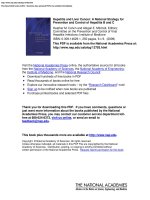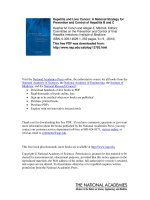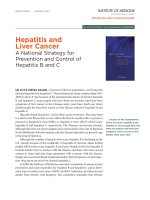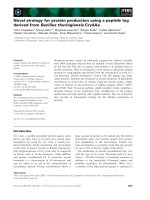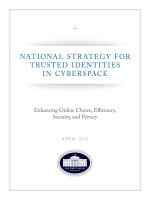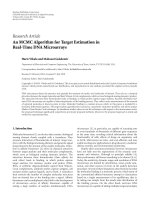NATIONAL STRATEGY FOR TRUSTED IDENTITIES IN CYBERSPACE: Enhancing Online Choice, Efficiency, Security, and Privacy pptx
Bạn đang xem bản rút gọn của tài liệu. Xem và tải ngay bản đầy đủ của tài liệu tại đây (2.39 MB, 52 trang )
APRIL 2011
Enhancing Online Choice, Eciency,
Security, and Privacy
NATIONAL STRATEGY FOR
TRUSTED IDENTITIES
IN CYBERSPACE
THE WHITE HOUSE
WASHINGTON
Table of Contents
Executive Summary . . . . . . . . . . . . . . . . . . . . . . . . . . . . 1
Introduction . . . . . . . . . . . . . . . . . . . . . . . . . . . . . . . 5
Guiding Principles . . . . . . . . . . . . . . . . . . . . . . . . . . . . . . . 11
Identity Solutions will be Privacy-Enhancing and Voluntary . . . . . . . . . . . . . . 11
Identity Solutions will be Secure and Resilient . . . . . . . . . . . . . . . . . . . 12
Identity Solutions will be Interoperable. . . . . . . . . . . . . . . . . . . . . . 13
Identity Solutions will be Cost-Eective and Easy To Use . . . . . . . . . . . . . . . 14
Vision . . . . . . . . . . . . . . . . . . . . . . . . . . . .
. . . . . . . . 15
Benets . . . . . . . . . . . . . . . . . . . . . . . . . . . . . . . . . . . 17
The Identity Ecosystem . . . . . . . . . . . . . . . . . . . . . . . . . . . . . 21
Goals and Objectives . . . . . . . . . . . . . . . . . . . . . . . . . . . . . . 29
Commitment to Action . . . . . . . . . . . . . . . . . . . . . . . . . . . . . 37
Role of the Private Sector . . . . . . . . . . . . . . . . . . . . . . . . . . . 37
Role of the Federal Government . . . . . . . . . . . . . . . . . . . . . . . . 37
Role of State, Local, Tribal, and Territorial Governments . . . . . . .
. . . . . . . . 39
Role of International Partners. . . . . . . . . . . . . . . . . . . . . . . . . . 40
Implementation Roadmap and Federal Government Actions . . . . . . . . . . . . . 40
Benchmarks . . . . . . . . . . . . . . . . . . . . . . . . . . . . . . . . 40
Conclusion . . . . . . . . . . . . . . . . . . . . . . . . . . . . . . . . . . 43
Appendix A – Fair Information Practice Principles (FIPPs) . . . . . . . . . . . . . . . . 45
1
★ ★
Executive Summary
A secure cyberspace is critical to our prosperity. We use the Internet and other online environments to
increase our productivity, as a platform for innovation, and as a venue in which to create new businesses.
“Our digital infrastructure, therefore, is a strategic national asset, and protecting it—while safeguarding
privacy and civil liberties—is a national security priority” and an economic necessity. By addressing
threats in this environment, we will help individuals protect themselves in cyberspace and enable both
the private sector and government to oer more services online.
As a Nation, we are addressing many of the technical and policy shortcomings that have led to inse-
curity in cyberspace. Among these shortcomings is the online authentication of people and devices:
the President’s Cyberspace Policy Review established trusted identities as a cornerstone of improved
cybersecurity.
In the current online environment, individuals are asked to maintain dozens of dierent usernames and
passwords, one for each website with which they interact. The complexity of this approach is a burden
to individuals, and it encourages behavior—like the reuse of passwords—that makes online fraud and
identity theft easier. At the same time, online businesses are faced with ever-increasing costs for man-
aging customer accounts, the consequences of online fraud, and the loss of business that results from
individuals’ unwillingness to create yet another account. Moreover, both businesses and governments
are unable to oer many services online, because they cannot eectively identify the individuals with
whom they interact. Spoofed websites, stolen passwords, and compromised accounts are all symptoms
of inadequate authentication mechanisms.
Just as there is a need for methods to reliably authenticate individuals, there are many Internet transac-
tions for which identication and authentication is not needed, or the information needed is limited.
It is vital to maintain the capacity for anonymity and pseudonymity in Internet transactions in order to
enhance individuals’ privacy and otherwise support civil liberties. Nonetheless, individuals and busi-
nesses need to be able to check each other’s identity for certain types of sensitive transactions, such as
online banking or accessing electronic health records.
The National Strategy for Trusted Identities in Cyberspace (NSTIC or Strategy) charts a course for the public
and private sectors to collaborate to raise the level of trust associated with the identities of individuals,
organizations, networks, services, and devices involved in online transactions.
1. Cyberspace is the interdependent network of information technology components that underpins many of our
communications; the Internet is one component of cyberspace.
2. “National Security Strategy.” The White House. May 2010, p. 27. Web. 17 Dec. 2010.
/>3. “Cyberspace Policy Review: Assuring a Trusted and Resilient Information and Communications Infrastructure.”
The White House. May 2009, p. 33. Web. 2 Jun. 2010. />Review_nal.pdf.
NATIONAL STRATEGY FOR TRUSTED IDENT I T IES IN CYBE RSPACE
2
★ ★
The Strategy’s vision is:
Individuals and organizations utilize secure, ecient, easy-to-use, and interoperable identity
solutions to access online services in a manner that promotes condence, privacy, choice, and
innovation.
The realization of this vision is the user-centric “Identity Ecosystem” described in this Strategy. It is an
online environment where individuals and organizations will be able to trust each other because they
follow agreed upon standards to obtain and authenticate their digital identities—and the digital iden-
tities of devices. The Identity Ecosystem is designed to securely support transactions that range from
anonymous to fully-authenticated and from low- to high-value. The Identity Ecosystem, as envisioned
here, will increase the following:
• Privacy protections for individuals, who will be able trust that their personal data is handled
fairly and transparently;
• Convenience for individuals, who may choose to manage fewer passwords or accounts than
they do today;
• Eciency for organizations, which will benet from a reduction in paper-based and account
management processes;
• Ease-of-use, by automating identity solutions whenever possible and basing them on technol-
ogy that is simple to operate;
• Security, by making it more dicult for criminals to compromise online transactions;
• Condence that digital identities are adequately protected, thereby promoting the use of
online services;
• Innovation, by lowering the risk associated with sensitive services and by enabling service
providers to develop or expand their online presence;
• Choice, as service providers oer individuals dierent—yet interoperable—identity credentials
and media.
Examples that illustrate some potential benets of the Identity Ecosystem can be found throughout the
Strategy within the “Envision It!” callout boxes.
The enhancement of privacy and support of civil liberties is a guiding principle of the envisioned Identity
Ecosystem. The Identity Ecosystem will use privacy-enhancing technology and policies to inhibit the
ability of service providers to link an individual’s transactions, thus ensuring that no one service provider
can gain a complete picture of an individual’s life in cyberspace. By default, only the minimum necessary
information will be shared in a transaction. For example, the Identity Ecosystem will allow a consumer
to provide her age during a transaction without also providing her birth date, name, address, or other
identifying data.
In addition to privacy protections, the Identity Ecosystem will preserve online anonymity and pseud-
onymity, including anonymous browsing. These eorts to enhance privacy and otherwise support
civil liberties will be part of, and informed by, broader privacy policy development eorts occurring
EXECU TIVE SUMMARY
3
★ ★
throughout the Administration. Equally important, participation in the Identity Ecosystem will be vol-
untary: the government will neither mandate that individuals obtain an Identity Ecosystem credential
nor that companies require Identity Ecosystem credentials from consumers as the only means to interact
with them.
The second guiding principle is that identity solutions must be secure and resilient. Trusted digital
identities are only one part of layered security, and online security will not be achieved through the
establishment of an Identity Ecosystem alone. However, more secure identication and authentication
will both ameliorate existing security failures and provide a critical tool with which to improve other
areas of online security. The Identity Ecosystem must therefore continue to develop in parallel with
ongoing national eorts to improve platform, network, and software security—and eorts to raise
awareness of the steps, both technical and non-technical, that individuals and organizations can take
to improve their security.
The third guiding principle of the Identity Ecosystem is to ensure policy and technology interoperability
among identity solutions, which will enable individuals to choose between and manage multiple dier-
ent interoperable credentials. Interoperability will also support identity portability and will enable service
providers within the Identity Ecosystem to accept a variety of credential and identication media types.
The fourth guiding principal is that the Identity Ecosystem must be built from identity solutions that are
cost-eective and easy to use. History and common sense tell us that privacy and security technology
is most eective when it exhibits both of these characteristics.
The Strategy will only be a success—and the ideal of the Identity Ecosystem will only be fullled—if the
guiding principles of privacy, security, interoperability, and ease-of-use are achieved. Achieving them
separately will not only lead to an inadequate solution but could serve as a hindrance to the broader
evolution of cyberspace. Specically, achieving interoperability without the appropriate security and
privacy measures could encourage abuses of personal and proprietary information beyond those that
occur today. However, this risk is more likely to be realized if we take no action: identity solutions in
cyberspace are already evolving. One key role for the Federal Government in the implementation of
this Strategy is to partner with the private sector to ensure that the Identity Ecosystem implements all
of the guiding principles. The Federal Government’s role is also to coordinate a whole-of-government
approach to implementation, including fostering cooperation across all levels of government, to deliver
integrated, constituent-centric services.
The Strategy emphasizes that some parts of the Identity Ecosystem exist today but recognizes that there
is much work still to be done. The Strategy seeks to promote the existing marketplace, encourage new
solutions where none exist, and establish a baseline of privacy, security, interoperability, and ease of
use that will enable the market to ourish. Central to the Strategy’s approach is the conviction that the
role of government in achieving the Identity Ecosystem is critical and must be carefully calibrated. On
the one hand, government should not over-dene or over-regulate the existing and growing market
for identity and authentication services. If government were to choose a single approach to develop
the Identity Ecosystem, it could inhibit innovation and limit private-sector opportunities. On the other
hand, the current market for interoperable and privacy-enhancing solutions remains fragmented and
incomplete, and its pace of evolution does not match the Nation’s needs.
NATIONAL STRATEGY FOR TRUSTED IDENT I T IES IN CYBE RSPACE
4
★ ★
The private sector will lead the development and implementation of this Identity Ecosystem, and it will
own and operate the vast majority of the services within it. The Identity Ecosystem should be market-
driven, and it should provide a foundation for the development of new and innovative services. The
Strategy’s approach is for the Federal Government to promote the emergence of an integrated land-
scape of solutions, building on a number of existing or new public and private initiatives to facilitate
the creation of the Identity Ecosystem. The role of the Federal Government is to support and enable
the private sector; lead by example in utilizing and oering these services; enhance the protection of
individuals; and ensure the guiding principles of privacy, security, interoperability, and ease of use are
implemented and maintained in the Identity Ecosystem.
The Federal Government is initiating two short-term actions to implement the Strategy. These are to:
• Develop an Implementation Roadmap that identies and assigns responsibility for actions
that the Federal Government can perform itself or by which the Federal Government can
facilitate private-sector eorts.
• Establish a National Program Office (NPO) for coordinating the activities of the Federal
Government and its private-sector partners. The NPO will be hosted at the Department of
Commerce and accountable to the President, through the Secretary of Commerce.
The complete Identity Ecosystem will take many years to develop, and achieving this vision will require
the dedicated eorts of both the public and private sectors. The Federal Government commits to
collaborate with the private sector; state, local, tribal, and territorial governments; and international
governments–and to provide the support and action necessary to make the Identity Ecosystem a reality.
With a concerted, cooperative eort from all of these parties, individuals will realize the benets of the
Identity Ecosystem through the conduct of their daily transactions in cyberspace.
The Way Forward
The National Program Oce will continue the national dialog among the private sector, public sector,
and individuals on the implementation of the Strategy. Shortly after the release of the Strategy, the NPO
will hold a series of meetings to highlight the existing work in this area and to support the private sector’s
standardization of policies and technology for the Identity Ecosystem.
Representatives from industry, academia, civil society organizations, standards-setting organizations, and
all levels of government are encouraged to attend and collaborate on the design of the Identity Ecosystem.
Together, we will work towards technology and policy standards that oer greater identity security and
convenience; create new commercial opportunities; and promote innovation, choice, and privacy.
5
★ ★
Introduction
Imagine a world where individuals can conduct sensitive business transactions online with reduced
fear of identity theft or fraud and without the need to manage scores of usernames and passwords.
They can seamlessly access information and services from the private sector, other individuals, and the
government. When they need to assert their identity online, they can choose from a number of dier-
ent types of credentials. They can choose to obtain those credentials from a range of dierent identity
providers, both private and public. Individuals can better trust the identities of the entities with which
they interact; as a result, they can conduct a wider array of transactions online to save time and eort. All
of these activities occur together with enhanced privacy protections that are built into the underlying
processes and technologies. At the same time, individuals will retain their existing options of anonymity
and pseudonymity in Internet transactions.
In this world, organizations eciently conduct business online by trusting the identities and credentials
provided by other entities. They can eliminate redundant processes associated with managing, authen-
ticating, authorizing, and validating identity data. They can reduce loss due to fraud or data theft, and
they can oer additional services previously deemed too risky to conduct online.
A Platform for Security, Privacy, and Innovation
For our Nation to continue to drive economic growth over the Internet, we must provide individuals and
organizations the ability and the option to securely identify each other. When individuals and organiza-
tions can trust online identities, they can oer and use online services too complex and sensitive to have
been otherwise available.
Some of the technologies needed to solve this problem are emerging. For low-assurance transactions,
individuals can already choose from a number of private-sector identity providers. Using these ser-
vices, individuals can use a single username and password to log in to many dierent websites, and the
website trusts a third-party “identity provider” to check the username and password. Although these
technologies provide a glimpse of the future, they have not addressed many of the signicant shortcom-
ings of the current environment. Most of today’s identity providers use relatively weak usernames and
passwords, and most individuals are unable to obtain high-assurance credentials with an acceptable
level of security, privacy and interoperability. Almost no existing solutions allow individuals to assert
their actual identities online, so the government and private sector are unable to oer online versions
of many high-value or more sensitive services.
4. The level of assurance in a transaction is the degree to which the parties need to know each other’s identity. In
a low-assurance transaction, you may not need to know exactly who the other party is. For a high assurance transaction,
you may want to know their true identity.
NATIONAL STRATEGY FOR TRUSTED IDENT I T IES IN CYBE RSPACE
6
★ ★
Acknowledging this need, the President’s Cyberspace Policy Review stated that:
“The Federal Government—in collaboration with industry and the civil liberties and privacy com-
munities—should build a cybersecurity-based identity management vision and strategy for the
Nation that considers an array of approaches, including privacy-enhancing technologies. The Federal
Government must interact with citizens through myriad information, services, and benet programs
and thus has an interest in the protection of the public’s private information as well.”
5
This Strategy answers that call. An interagency team received vital input from the private sector—
through eighteen critical infrastructure/key resource sectors, nearly seventy dierent non-prots and
Federal advisory groups, and a public comment period—to develop the National Strategy for Trusted
Identities in Cyberspace (NSTIC).
The Federal Government is already seeking to create this world for its own operations by executing the
Federal Identity, Credential, and Access Management (FICAM) Roadmap. The Strategy seeks to acceler-
ate those activities and to foster the development of an Identity Ecosystem in which trusted identities
are available to any individual or organization.
Motivation
The Nation faces a host of increasingly sophisticated threats to the personal, sensitive, nancial, and
condential information of organizations and individuals. Fraudulent transactions within the banking,
retail, and other sectors—along with online intrusions into the Nation’s critical infrastructure, such as
electric utilities—are all too common. As more commercial and government services become available
online, the amount of sensitive information transmitted over the Internet will increase. Consequently, the
probability of loss associated with data theft, unauthorized modications, fraud, and privacy breaches
will also increase. Although the total amount of losses—both nancial and non-nancial—due to online
fraud and cybercrime is dicult to quantify, the problem is real and it is increasing.
Furthermore, the online environment today is not user-centric. Individuals tend to have little ability to
manage their own personal information once it is released to service providers, and they often must
calculate the tradeos among security, privacy, and gaining access to a service they desire. In addition,
individuals have limited ability to use strong digital identities across multiple applications, because
5. “Cyberspace Policy Review: Assuring a Trusted and Resilient Information and
Communications Infrastructure.” The White House. May 2009, p. 33. Web. 2 Jun. 2010.
/>6. See “Federal Identity, Credential, and Access Management (FICAM) Roadmap and Implementation
Guidance” Federal Chief Information Ocers Council and the Federal Enterprise Architecture, Web. 2 Jun. 2010
/>7. The 2009 Internet Crime Report states, “From January 1, 2009, through December 31, 2009, the Internet
Crime Complaint Center (IC3) Web site received 336,655 complaint submissions. This was a 22.3% increase as
compared to 2008…the total dollar loss from all referred cases was $559.7 million…up from $264.6 million in
2008. – “2009 Internet Crime Report.” Internet Crime Complaint Center. IC3. 12 Mar. 2010, p. 14. Web. 2 Jun. 2010.
/>Over 10 million Americans are also victims of identity theft each year. – “The Department of Justice’s Eorts
to Combat Identity Theft.” U.S. Department of Justice. Oce of the Inspector General. Mar. 2010. Web. 2 Jun. 2010.
/>A Federal Trade Commission survey found that some victims of identity theft can spend more than 130
hours reconstructing their identities (e.g., credit rating, bank accounts, reputation, etc.) following an identity
crime. – “2006 Identity Theft Survey Report.” Federal Trade Commission. Nov. 2007 p. 6. Web. 2 Jun. 2010.
/>INT RODUCTION
7
★ ★
application and service providers do not use a common framework. Instead, they face the increasing
complexity and inconvenience associated with managing the large number of usernames, passwords,
and other identity credentials required to conduct services online with disparate organizations.
Finally, the collection of identity-related information across multiple providers, coupled with the shar-
ing of personal information through the growth of social media, increases the opportunity for data
compromise. For example, the personal data that individuals use as “prompts” to recover lost passwords
(mother’s maiden name, the name of a rst pet, etc.) is often publicly available or easily obtained.
The benets of a widely-deployed, broadly-adopted Identity Ecosystem are as signicant as the draw-
backs of continuing along the current path. Widespread fraud, data breaches, and the ineciencies of
authenticating parties to online transactions impose economic losses, diminish trust, and prevent some
services from being oered online. These tradeos and shortcomings are not necessary; innovative
technologies exist that can provide security and privacy protections while simultaneously granting
individuals access to services they desire.
1. Envision It!
Mary is tired of remembering dozens of user names and passwords, so she obtains a digital credential from
her Internet service provider that is stored on a smart card. Now that she has the smart card, she is also
willing to conduct more sensitive transactions, like managing her healthcare, online. One morning, she
inserts the smart card into her computer, and uses the credential on it to “run” some errands, including:
• Logging in to her bank and obtaining digital cash;
• Buying a sweater at a new online retailer—without having to open an account;
• Signing documents to renance her mortgage;
• Reading the note her doctor left in her personal health record, in response to the blood sugar statistics
she had uploaded the day before;
• Sending an email to conrm dinner with a friend; and
• Checking her day’s schedule on her employer’s intranet portal.
In just minutes, she is done with her errands and has plenty of time to stop at the local coee shop on her
way to work.
NATIONAL STRATEGY FOR TRUSTED IDENT I T IES IN CYBE RSPACE
8
★ ★
Scope
The Strategy focuses on ways to establish and maintain trusted digital identities, which are critical for
improving the security of online transactions. Online transactions are electronic communications
among two or more parties, connected via networks, systems, and computers. Technology and processes
for identication (establishing unique digital identities) and authentication (verifying the identity of a
user, process, or device) are at the forefront of this Strategy. In addition, the Strategy focuses on ways of
providing trusted and validated attributes to enable organizations to make decisions about authoriza-
tion (approving or giving consent for access). Identication, authentication, and authorization provide
the information and assurances necessary for the parties within a given transaction to trust each other.
Individuals, organizations, hardware, networks, and software are all participants in an online transaction;
therefore, each of these may be identied, authenticated, and authorized.
The Strategy recognizes that trusted digital identity, authentication and authorization processes are
one part of layered security. Improvements in identication and authentication are critical to attaining
a trusted online environment; however, they must be combined with other crucial aspects of cyberse-
curity. They must develop in parallel with ongoing national eorts to improve platform, network, and
software security—and to raise awareness of the steps, both technical and non-technical, that individuals
and organizations can take to improve their security. While the Strategy does not address these other
essential eorts, it anticipates that many co-evolving solutions in these areas will need to use trusted
identities and improved authentication if we are to improve the security of cyberspace.
The identity aspects of securing online transactions are
a subset of the overall identity management sphere.
The Strategy does not explicitly address identity and
trust issues in the oine world; however, oine and
online identity solutions can and should complement
each other. Identity proong (verifying the identity of
an individual) and the quality of identity source docu-
ments have a profound impact on establishing trusted
digital identities, but the Strategy does not prescribe
how these processes and documents need to evolve.
Lastly, the Strategy does not advocate for the establish-
ment of a national identication card or system. Nor
does the Strategy seek to circumscribe the ability of
individuals to communicate anonymously or pseud-
onymously, which is vital to protect free speech and
freedom of association. Instead, the Strategy seeks to
provide to individuals and organizations the option
of interoperable and higher-assurance credentials
to supplement existing options, like anonymity or
pseudonymity.
2. Envision It!
A power utility remotely manages “Smart
Grid” software deployed on an electricity
meter.
• Secure authentication between the power
company and the meter prevents criminals
from deploying fraudulent meters to steal
electricity.
• Trusted hardware modules ensure that the
hardware and software congurations on
the meter are correct.
• The meter validates that instructions and
periodic software upgrades actually come
from the power company.
Trusted interactions among hardware,
software, and organizations reduce the threat
of fraudulent activity and the deployment of
malware within the Smart Grid.
INT RODUCTION
9
★ ★
Public-Private Collaboration
The private sector and all levels of government, working together, can foster both economic prosperity
and cybersecurity by overcoming the barriers that inhibit the adoption of more trustworthy identities
in cyberspace. Such barriers include:
• Concerns regarding personal privacy;
• Lack of secure, convenient, user-friendly options for authentication and identication;
• Uncertainty regarding the allocation and level of liability for fraud or other failures; and
• The absence of a common framework to help establish trusted identities across a diverse land-
scape of online transactions and constituents.
To bring this world to fruition, close collaboration between the public and private sectors is crucial.
8. In this document, “all levels of government” includes Federal, state, local, tribal, and territorial government.
11
★ ★
Guiding Principles
The Strategy species four Guiding Principles to which the Identity Ecosystem must adhere:
• Identity solutions will be privacy-enhancing and voluntary
• Identity solutions will be secure and resilient
• Identity solutions will be interoperable
• Identity solutions will be cost-eective and easy to use
These principles form the foundation for all of the Strategy’s goals, objectives, and actions. The Strategy
will only be a success—and the ideal of the Identity Ecosystem will only be fullled—if these Guiding
Principles are achieved.
Identity Solutions will be Privacy-Enhancing and Voluntary
The oine world has structural barriers that preserve
individual privacy by limiting information collection,
use, and disclosure to a specic context. For example,
consider a driver’s license: an individual can use a
driver’s license to open a bank account, board an air-
plane, or view an age-restricted movie at the cinema,
but the Department of Motor Vehicles does not know
every place that accepts driver’s licenses as identica-
tion. It is also dicult for the bank, the airport, and the
movie theater to collaborate and link the transactions
together. At the same time, there are aspects of these
oine transactions that are not privacy-protective.
The movie theater attendant who checks an indi-
vidual’s driver’s license needs to know only that the
individual is over age 17. But looking at the driver’s
license reveals extraneous information, such as the
individual’s address and full date of birth.
Ideally, identity solutions should preserve the positive privacy benets of oine transactions while
mitigating some of the negative privacy aspects. The Fair Information Practice Principles (FIPPs) are the
widely accepted framework for evaluating and mitigating privacy impacts. The eight FIPPs are transpar-
ency, individual participation, purpose specication, data minimization, use limitation, data quality and
integrity, security, and accountability and auditing.
9. See Appendix A to this document for details on the Fair Information Practice Principles.
3. Envision It!
Antonio, age thirteen, wants to enter an online
chat room that is specically for adolescents,
between the ages of twelve and seventeen.
His parents give him permission to get a digital
credential from his school. His school also acts
as an attribute provider: it validates that he
is between the age of twelve and seventeen
without actually revealing his name, birth
date or any other information about him.
The credential employs privacy-enhancing
technology to validate Antonio’s age without
informing the school that he is using the cre-
dential. Antonio can speak anonymously but
with condence that the other participants are
between the ages of twelve and seventeen.
NATIONAL STRATEGY FOR TRUSTED IDENT I T IES IN CYBE RSPACE
12
★ ★
The envisioned Identity Ecosystem will be grounded in a holistic implementation of the FIPPs in order
to provide multi-faceted privacy protections. For example, organizations will collect and distribute only
the information necessary to the transaction, maintain appropriate safeguards on that information, and
be responsive and accountable to individuals’ privacy expectations. In circumstances where individuals
make choices regarding the use of their data (such as to restrict particular uses), those choices will be
automatically applied to all parties with whom that individual interacts. Consistent with the FIPPs-based
approach, the Identity Ecosystem will include limits on the length of time organizations can retain
personal information and will require them to provide individuals with appropriate opportunities to
access, correct, and delete it. The Identity Ecosystem will also require organizations to maintain auditable
records regarding the use and protection of personal information.
Moreover, a FIPPs-based approach will promote the creation and adoption of privacy-enhancing
technical standards. Such standards will minimize the transmission of unnecessary information and
eliminate the superuous “leakage” of information that can be invisibly collected by third parties. Such
standards will also minimize the ability to link credential use among multiple service providers, thereby
preventing them from developing a complete picture of an individual’s activities online. Finally, service
providers will request individuals’ credentials only when necessary for the transaction and then only as
appropriate to the risk associated with the transaction. As a result, implementation of the FIPPs will pro-
tect individuals’ capacity to engage anonymously in cyberspace. Universal adoption of the FIPPs in the
envisioned Identity Ecosystem will enable a variety of transactions, including anonymous, anonymous
with validated attributes, pseudonymous, and uniquely identied—while providing robust privacy
protections that promote usability and trust.
Finally, participation in the Identity Ecosystem will be voluntary: the government will neither mandate
that individuals obtain an Identity Ecosystem credential nor that companies require Identity Ecosystem
credentials from consumers as the only means to interact with them. Individuals shall be free to use
an Identity Ecosystem credential of their choice, provided the credential meets the minimum risk
requirements of the relying party, or to use any non-Identity Ecosystem mechanism provided by
the relying party. Individuals’ participation in the Identity Ecosystem will be a day-to-day—or even a
transaction-to-transaction—choice.
Identity Solutions will be Secure and Resilient
Identity solutions and the processes and techniques used to establish trust must be secure against
attack or misuse. Security ensures the condentiality, integrity, and availability of identity solutions and,
when appropriate, the non-repudiation of transactions. The use of open and collaboratively developed
security standards and the presence of auditable security processes are critical to an identity solution’s
trustworthiness. Identity solutions must have security built into them so that whenever possible, the
security is transparent to the user.
Identity solutions will provide secure and reliable methods of electronic authentication. Authentication
credentials are secure when they are (a) issued based on sound criteria for verifying the identity of indi-
viduals and devices; (b) resistant to theft, tampering, counterfeiting, and exploitation; and (c) issued only
by providers who fulll the necessary requirements. In addition, the ability to support robust forensic
GUIDING P RINC IPLES
13
★ ★
capabilities will maximize recovery eorts, enable enhancements to protect against evolving threats, and
permit attribution, when appropriate, to ensure that criminals can be held accountable for their activities.
Reliable identity solutions will also be available and resilient. Identity solutions are available when they
meet appropriate service-level requirements agreed upon by the individuals and organizations that
use them. Credentials are resilient when they can recover from loss, compromise, theft—and can be
eectively revoked or suspended in instances of misuse. Another contributor to resilience is the existence
of a diverse and heterogeneous environment of providers and methods of authentication. In a diverse
ecosystem, a participant can easily switch providers if their existing provider becomes insolvent, inca-
pable of adhering to policies, or revises their terms of service.Identity solutions must detect when trust
has been broken, be capable of timely restoration after any disruption, be able to quickly revoke and
recover compromised digital identities, and be capable of adapting to the dynamic nature of technology.
Identity Solutions will be Interoperable
Interoperability encourages service providers to accept a variety of credential and identity media, simi-
lar to the way ATMs accept credit and debit cards from dierent banks. Interoperability also supports
identity portability: it enables individuals to use a variety of credentials in asserting their digital identity
to a service provider. Finally, the interoperability of identity solutions envisioned in this Strategy will
enable individuals to easily switch providers, thus harnessing market incentives to meet individuals’
expectations.
This guiding principle recognizes two interoperability ideals within the Identity Ecosystem:
• There will be standardized, reliable credentials and identity media in widespread use in both
the public and private sectors; and
• If an individual, device, or system presents a valid and appropriate credential, any qualied rely-
ing party is capable of accepting and verifying the credential as proof of identity and attributes.
To achieve these ideals, identity solutions should be scalable across multiple communities, spanning
traditional geographic borders. Interoperable identity solutions will allow organizations to accept and
trust external users authenticated by a third party. Identity solutions achieve scalability when all par-
ticipants in the various identity federations agree upon a common set of standards, requirements, and
accountability mechanisms for securely exchanging digital identity information, resulting in authentica-
tion across identity federations.
Identity solutions will achieve at least two types of interoperability: technical and policy-level. Technical
interoperability (including semantic interoperability) refers to the ability for dierent technologies to
communicate and exchange data based upon well-dened and testable interface standards. Policy-
level interoperability is the ability for organizations to adopt common business policies and processes
(e.g., liability, identity proong, and vetting) related to the transmission, receipt, and acceptance of data
between systems.
There are many existing standards and standards organizations that address these issues, and the
Identity Ecosystem will encourage the use of existing, non-proprietary solutions. When new standards
NATIONAL STRATEGY FOR T RUSTED IDENT I T IES IN CYBERSPACE
14
★ ★
are needed, the Identity Ecosystem will emphasize non-proprietary, international, and industry-led stan-
dards. In addition, identity solutions will be modular, allowing service providers to build sophisticated
identity systems using smaller and simpler sub-systems. This implementation philosophy will improve
the exibility, reliability, and reuse of these systems, and it will allow for simplicity and eciency in
change management: service providers can add and remove components as the Identity Ecosystem
evolves.
Identity Solutions will be Cost-Eective and Easy To Use
From the individual’s perspective, the increasing complexity and risk of managing multiple credentials
threaten the convenience associated with online transactions.
The Identity Ecosystem will promote identity solutions that
foster the reduction and elimination of policy and technology
silos that require individuals to maintain multiple identity cre-
dentials. Individuals will be able to establish a small number
of identity credentials that they can leverage across a wide
variety of service providers. Organizations will no longer have
to issue and maintain credentials for each of their users.
Individuals, businesses, organizations, and all levels of gov-
ernment will benet from the reduced cost of online transac-
tions: fewer redundant account procedures, a reduction in
fraud, decreased help-desk costs, and a transition away from
expensive paper-based processes. Furthermore, reusable
identity solutions promote operational eciency and will
further reduce the cost of implementing online services. The use of existing identity solutions that align
with the Strategy is one way of quickly achieving these eciencies.
Identity solutions should be simple to understand, intuitive, easy-to-use, and enabled by technology that
requires minimal user training. Many existing technology components in widespread use today, such
as cell phones, smart cards, and personal computers, can be leveraged to act as or contain a credential.
Whenever possible, identity solutions should be built into online services to enhance their usability.
Identity solutions must also bridge the ‘digital divide’; they must be available to all individuals, and they
must be accessible to the disadvantaged and disabled.
4. Envision It!
Parvati uses a credential, issued by a
third party and bound to her existing
cell phone, to access online govern-
ment tax services. She can log in with
the click of a button: she no longer
has to remember the complicated
password she previously had to use.
She views her tax history, changes her
demographic information, les her
taxes electronically, and monitors her
refund status.
15
★ ★
Vision
Consistent with the Guiding Principles, the vision of the National Strategy for Trusted Identities in
Cyberspace is:
Individuals and organizations utilize secure, ecient, easy-to-use and interoperable identity
solutions to access online services in a manner that promotes condence, privacy, choice, and
innovation.
The vision applies to individuals, businesses, non-prots, advocacy groups, associations, and govern-
ments at all levels. It cannot be accomplished without the close cooperation between the public and
private sectors. It also reects the user-centric nature of the Identity Ecosystem, which provides greater
transparency, privacy protection, exibility, and choice to the individual.
Working from this collectively developed vision, the remainder of the Strategy plots the journey the
Nation must undertake—led by the private sector and enabled by all levels of government—to attain
an operational Identity Ecosystem.
17
★ ★
Benets
The benets of the envisioned Identity Ecosystem for individuals, the private sector, and governments
are closely intertwined. Nevertheless, each experiences the benets of the Identity Ecosystem through
the lens of its particular interests and concerns.
Benets for Individuals
• Convenience. Individuals will be able to con-
duct their personal business online with less
time and eort. They will be able to access ser-
vices easily without having to manage many
dierent usernames and passwords.
• Privacy. Individuals’ privacy will be enhanced.
The Identity Ecosystem will limit the amount
of identifying information that is collected and
transmitted in the course of online transactions.
It will also protect individuals from those who
would link individuals’ transactions in order to
track individuals’ online activities.
• Security. Individuals can work and play online
with fewer concerns about identity theft.
Stronger authentication will limit unauthorized
transactions, and decreasing the transmission
of identifying information will result in less risk
from data breaches.
Benets for the Private Sector
• Innovation. The Identity Ecosystem will provide a platform on which new or more ecient
business models will be developed—just as the Internet itself has been a platform for innova-
tion. The Identity Ecosystem will enable new forms of online alliances and co-branding. It will
also enable organizations to put new services online, especially for sectors such as healthcare
and banking. Early adopters can leverage innovative solutions within the Identity Ecosystem
to dierentiate their brands in the marketplace.
• Eciency. Online transactions will be practical in more situations. The private sector will have
lower barriers to customer enrollment, increased productivity, and decreased costs. Cross-
organizational trust will provide businesses with exposure to a large population of potential
customers they might not otherwise reach. Not only is there potential access to new customers,
the traditional barriers associated with customer enrollment can be eliminated, reducing a
5. Envision It!
Ann learns that her recently issued bank
card and her new university card are both
Identity Ecosystem-approved credentials.
She also discovers that her email provider
and social networking site accept both of
these credentials, while her health care
provider and local utility companies accept
the higher assurance bank card. Ann decides
to log in to her email and social network-
ing site using her university card, but uses
her bank card to log in to her health and
utility services. Now she no longer has to
remember tens of dierent usernames
and passwords and can conduct dierent
risk transactions with appropriate levels of
authentication, all without having to obtain
an additional credential.
NATIONAL STRATEGY FOR T RUSTED IDENT I T IES IN CYBERSPACE
18
★ ★
friction that prevents potential customers from using a service. The consistency and accuracy
of trusted digital identities will improve productivity by, for example, reducing paper-based
processes and the help-desk costs associated with account management and password main-
tenance. Losses due to fraud and identity theft will also be reduced.
• Trust. Trusted digital identities will allow organizations to better display and protect their brands
online. Participants in the Identity Ecosystem will also be more trusted, because they will have
agreed to the Identity Ecosystem’s minimum standards for privacy and security.
6. Envision It!
A small business wants to start an online store. It decides that participating in the Identity Ecosystem will
eliminate the need to develop costly account management features. Moreover, the eort required for a
potential customer to establish an account at the store will be decreased—in many cases customers will
not need to establish an account at all in order to make a purchase.
The business wants the full benets of the Identity Ecosystem, so it meets the published, transparent
requirements and receives a “trustmark.” Customers can see that trustmark and know that the business
complies with the policies of the Identity Ecosystem.
The business then selects three types of credentials that meet its security requirements. There are twelve
identity providers that meet the businesses requirements, and they have issued a total of thirty million
credentials.
As a result, the business immediately has a base of millions of potential customers who can safely and eas-
ily shop at the online store without enduring the inconvenience of manually entering information to create
an account.
Benets for Government
• Constituent Satisfaction. The Identity Ecosystem will enable government to expand its online
services in order to serve its constituents more eciently and transparently (while still oering
in-person services for those who prefer them). It will also enable increased integration among
government service providers to coordinate and deliver services to constituents. Technology
initiatives, such as the Smart Grid and Health Information Technology, can leverage the capabili-
ties of the Identity Ecosystem to increase participation in the initiative.
• Economic Growth. Government support of the Identity Ecosystem will generate innovation in
the marketplace that will create new business opportunities and advance U.S. business goals
in international trade.
• Public Safety. Increasing online security will reduce cyber crime, improve the integrity of
networks and systems, and raise overall consumer safety levels. Enhanced online trust will also
provide a platform to support more eective and adaptable response to national emergencies.
BENEFITS
19
★ ★
The benets just highlighted—and those that will develop over time—will result not from any single
component of the Identity Ecosystem but from the emergence of the Identity Ecosystem as a new
national platform.
7. Envision It!
A large national emergency erupts on the coastline and a call for support results in an inux of rst
responders at the emergency site.
A federal agency is tracking the event using their global satellite network, and can share detailed informa-
tion to state and local ocials, utility providers, and emergency rst responders from all over the country.
Each participant in the information exchange uses an interoperable credential issued by his employer to
log into the information-sharing portal. The portal automatically directs responders to information relevant
to them based on their duties and aliated organization.
Joel, a doctor, logs in and sees the triage report with injury lists at each of the local emergency shelters. The
hospital where he is a resident acts as the attribute provider to verify his status as a doctor and his specialty.
The portal indicates that his specialty is in high demand at a center half a mile away, where there is a long
waiting time for care.
In addition, Joel accesses an application on his registered cell phone to track changing local conditions. It
warns him that two bridges in his area have recently been reported as unsafe and one intersection should
be avoided. Joel uses this information to safely navigate to the center where he can be authenticated as a
licensed specialist and can most help the victims of the emergency.


